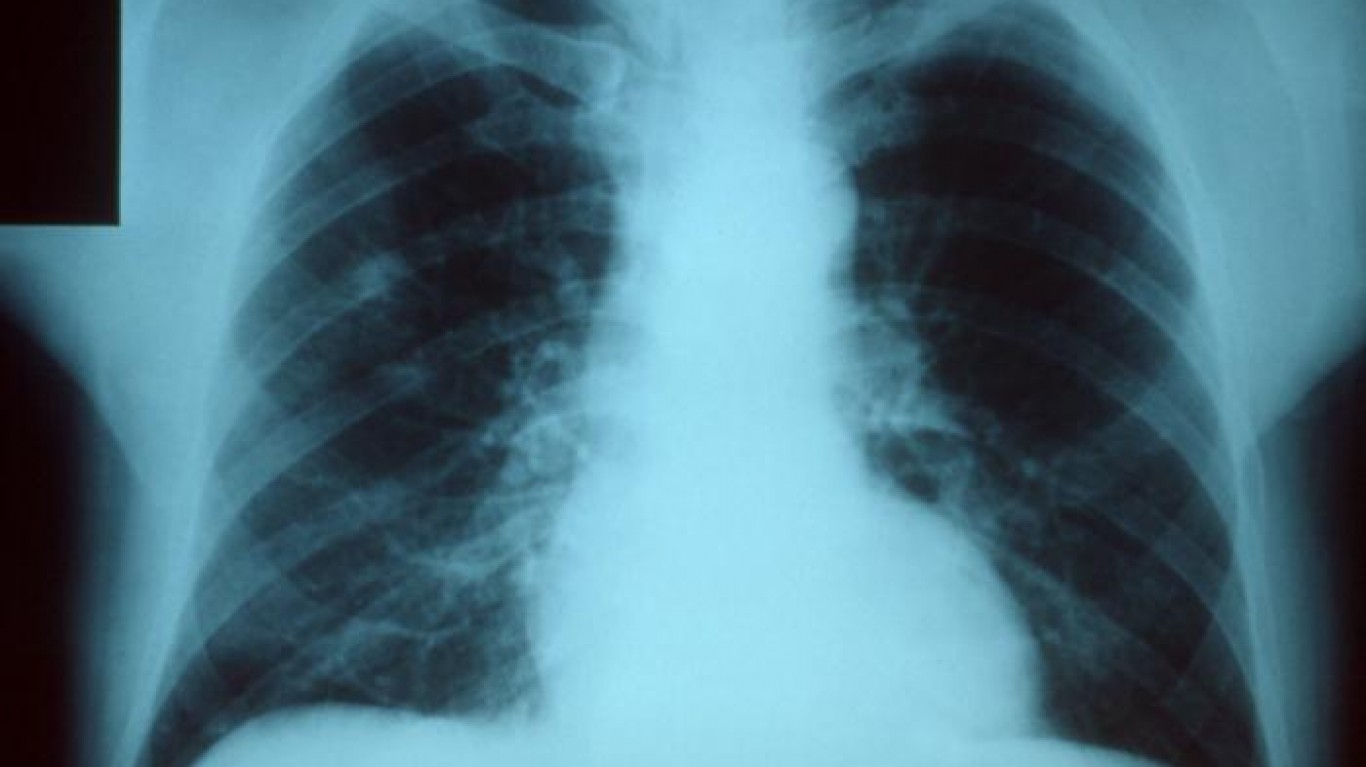Special Report
The 10 Most Surprising Health Complications From the Flu

Published:
Last Updated:

The flu is a common viral infection that can be deadly. In fact, the 2017-2018 flu season, the first to be classified as high severity across all age groups, was the deadliest since tracking began in 1976, killing 80,000 people in the United States alone. The 2019-2020 flu season has so far not been as severe, but the number of areas reporting regional or widespread flu activity has increased over the last few weeks, according to the CDC. More than 3% of doctors visits were for flu-like illness, higher than the national baseline of 2.4% for five weeks.
The flu is unpredictable and the severity of the season varies from year to year. CDC estimates that so far this season there have been at least 2.6 million flu illnesses, 23,000 hospitalizations and 1,300 deaths from flu. To identify the most serious flu complications, 24/7 Tempo talked to doctors and reviewed several studies published in various medical journals.
There is no cure but there are ways you can ease the symptoms. The majority of people with the flu take seven to 10 days to get healthy again, Dr. Dyan Hes, Medical Director of Gramercy Pediatrics in New York City, said. You can take medication to help with headaches, coughing and vomiting, but they won’t stop the flu, they will just treat the symptoms.
Mild complications such as body aches, dehydration and vomiting are common, but more serious health risks can develop as well. “The youngest and the oldest are by far the most at risk because their immune system is weak or compromised,” she added. Approximately 80% of the children who died from the flu during the last flu season had not received a flu shot. The single best way to prevent the infection, according to doctors and the CDC, is to get vaccinated each year.
The flu can make even healthy people very sick, Hes said. You don’t have to be weak or have a pre-existing condition to suffer severe complications, she added. “It kills healthy people, too.” This is just one reason why health experts worry about people catching the flu — along with these other infections even doctors are afraid of.
Click here to read about the surprising and serious health complications from the flu.

1. Asthma flare-ups
Asthma flare-ups are very common among people who have the flu, according to Hes. “You should consult with your doctor to see if you need to increase your asthma medication,” she added. The issue is that people with asthma already have swollen and sensitive airways, and the flu virus can cause further inflammation. The resulting infection can trigger an attack and worsen asthma symptoms.
[in-text-ad]

2. Pneumonia
Pneumonia, which is a serious infection or inflammation of the air sacs in the lungs, can develop due to the flu, but most cases don’t progress this far, Hes said. “If it’s viral pneumonia, it just has to run its course.”
Severe cases can be fatal. In fact, the Centers for Disease Control and Prevention ranked pneumonia and the flu as the eighth leading cause of death in 2016. The CDC recommends pneumococcal vaccination to help prevent pneumonia for all adult ages 65 and older, as well as other groups at high risk.

3. Seizures
“Like any other infection, it can enter the brain and cause meningitis or seizures, but this is very rare,” Hes said. Children with the flu and a temperature higher than 100.4 F may have febrile seizures, the symptoms of which are convulsions and jerking movements.
Seizures are not common in adults. In a population-based study in California on the neurological complications associated with severe and fatal flu, seizures were reported in 44 patients, only six of whom were adults, and all of whom had neurologic or metabolic disorders facilitating the seizures.

4. Premature labor
Premature labor is a risk for women who are sick from any cause, not because of the particular virus, Hes said. A pregnant woman’s immune system is weaker in general, and is further weakened fighting the illness.
During the flu pandemic of 2009–2010, pregnant women were more likely to be hospitalized or admitted to intensive care units, and were at higher risk of death compared to women who were not pregnant. Vaccination remains the most effective intervention to prevent severe illness, according to the National Institutes of Health.
[in-text-ad-2]

5. Heart attack
If you already have heart disease, your immune system is susceptible and the flu will make everything worse, Hes said. Studies show the risk of heart attacks increases in the first week after flu diagnosis. More stress on the heart due to the infection means it has to work harder to pump blood. Also, the increased inflammation due to the flu can lead to more blood clotting. People with heart conditions and who have had a stroke are at higher risk of developing serious complications, according to the CDC.
For adults hospitalized with flu during the last influenza season, heart disease was among the most commonly occurring chronic condition — about half of those hospitalized had heart disease.

6. Worsens diabetes
Diabetes can make the immune system less effective against infections and the flu can make it even harder to control your blood sugar, Hes said. Eating at regular intervals, which is important for diabetics, can also be disrupted because they just don’t have an appetite when sick, she added. Not eating can cause blood sugar levels to fall. Hypoglycemia can cause headaches, shaky legs, confusion, and even seizures, and it needs to be treated quickly.
[in-text-ad]

7. Inflammation of the muscles
Myositis, or inflammation of the muscle, is serious, Hes said. It hurts to move and to touch anything with your arms or legs. “Ibuprofen helps,” Hes added. The virus enters the muscle tissue, releasing substances that damage the muscle fibers. Acute viral myositis is rare and occurs during the recovery phase of an illness, most commonly the flu. Research shows that muscle inflammation is most common in children.

8. Bronchitis
“This is another inflammation process in the lungs,” Hes said. The bronchial tubes carry air to and from the lungs. “There are no medications; you have to let it run its course.” You can just soothe the coughing, which may last for weeks. Acute bronchitis, which is also called a chest cold, is usually caused by a viral infection such as the flu.

9. Severe vomiting
Vomiting and diarrhea from the flu are more common in children than adults. Severe and persistent vomiting is an emergency warning sign, according to the CDC. Your body may lose a lot of liquid combating a flu infection and become extremely dehydrated, which requires medical attention. But keep in mind that the ER is for very sick patients, who can be in real danger if they catch the flu from you, Hes said. “Go there if you’re experiencing bad shortness of breath and can’t walk.” Urgent care centers will suffice in most other cases, she added.
[in-text-ad-2]

10. Sinus and ear infections
Sinus and ear infections are common, but not serious and very treatable with a course of antibiotics, Dr. Hes said. Extra secretion builds up in the upper airway, blocking the Eustachian tube, which drains fluids away. It also connects the middle ear with the upper respiratory tract. That’s why germs in the nose or sinus cavities can make their way to the ear and start growing. Sinuses are filled with air, but when they get blocked with fluid (think sniffles from the flu), bacteria can grow and cause an infection.
The thought of burdening your family with a financial disaster is most Americans’ nightmare. However, recent studies show that over 100 million Americans still don’t have proper life insurance in the event they pass away.
Life insurance can bring peace of mind – ensuring your loved ones are safeguarded against unforeseen expenses and debts. With premiums often lower than expected and a variety of plans tailored to different life stages and health conditions, securing a policy is more accessible than ever.
A quick, no-obligation quote can provide valuable insight into what’s available and what might best suit your family’s needs. Life insurance is a simple step you can take today to help secure peace of mind for your loved ones tomorrow.
Click here to learn how to get a quote in just a few minutes.
Thank you for reading! Have some feedback for us?
Contact the 24/7 Wall St. editorial team.